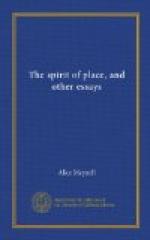If, especially in England, we make rough and reluctant bells go in gay measures, when we whip them to run down the scale to ring in a wedding—bells that would step to quite another and a less agile march with a better grace—there are belfries that hold far sweeter companies. If there is no music within Italian churches, there is a most curious local immemorial music in many a campanile on the heights. Their way is for the ringers to play a tune on the festivals, and the tunes are not hymn tunes or popular melodies, but proper bell-tunes, made for bells. Doubtless they were made in times better versed than ours in the sub-divisions of the arts, and better able to understand the strength that lies ready in the mere little submission to the means of a little art, and to the limits—nay, the very embarrassments—of those means. If it were but possible to give here a real bell-tune—which cannot be, for those melodies are rather long—the reader would understand how some village musician of the past used his narrow means as a composer for the bells, with what freshness, completeness, significance, fancy, and what effect of liberty.
These hamlet-bells are the sweetest, as to their own voices, in the world. Then I speak of their antiquity I use the word relatively. The belfries are no older than the sixteenth or seventeenth century, the time when Italy seems to have been generally rebuilt. But, needless to say, this is antiquity for music, especially in Italy. At that time they must have had foundries for bells of tender voices, and pure, warm, light, and golden throats, precisely tuned. The hounds of Theseus had not a more just scale, tuned in a peal, than a North Italian belfry holds in leash. But it does not send them out in a mere scale, it touches them in the order of the game of a charming melody. Of all cheerful sounds made by man this is by far the most light-hearted. You do not hear it from the great churches. Giotto’s coloured tower in Florence, that carries the bells for Santa Maria del Fiore and Brunelleschi’s silent dome, does not ring more than four contralto notes, tuned with sweetness, depth, and dignity, and swinging one musical phrase which softly fills the country.




